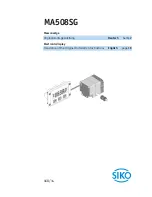
Theory of Operation
1735 HD High Definition Waveform Monitor
4–23
The front-panel intensity control sets the currents for U44A and U44B via
U46B. U21A and U21B switch the current sources off during off-screen
blanking, retrace blanking, and display blanking during readout time. The
LINSTEP signal turns current source U44A on to boost the trace brightness
during line select mode only.
The front-panel readout intensity control sets the current for U45B via
U46A. The ROBLANK signal switches the current source off except during
readout time.
Indicators and Switches.
The front-panel LED indicators are arranged in seven
columns returned to a current source by four returns, designated as rows, in order
to provide the microprocessor with a set of column/row matrix addresses. An
LED indicator lights when there is a complete circuit from the light driver (U34
on Diagram 8) through the LED and back to ground through the light driver
transistor array (U37 on Diagram 8).
Switches complete a simple matrix that is read by port 1 of the microprocessor.
Key condition (depressed front-panel switch) is detected using the row/column
lines (ROW0–ROW3 and COL0–COL3). These lines, and their connections to
the front-panel switches, are shown in Diagram 13. For this example, suppose
that the front-panel REF switch is depressed. To poll the switches, the controller
resets all of the row lines low and sets all of the column lines high. It then
monitors the column lines, waiting for one of them to be pulled low (indicating a
depressed key condition).
To determine which key is depressed, the Controller first sets all row/column
lines high except ROW0, which is reset low. Next, the controller looks at the
column lines again. Since the CH 2, CH 3, A, and B keys are tied to ROW0, and
ROW0 is low, if one of those keys were depressed, the corresponding column
line would be pulled low. In this case, the controller does not find a low on any
of the column lines, so it is known that the depressed key is not CH 2, CH 3, A,
or B.
The controller next sets ROW0 high and resets ROW1 low. Again it looks at the
column lines. Since one of the switches connected to ROW1 is depressed (REF),
the controller finds that the corresponding column line (COL2) has now been
forced low. The controller now knows that the depressed key is REF, and
responds by turning on the front-panel REF LED and the associated control I/O.
After finding a key condition, the controller debounces and checks again.
Front Panel
Diagram <13>
Summary of Contents for 070-8462-03
Page 5: ......
Page 13: ...Table of Contents viii 1735 HD High Definition Waveform Monitor...
Page 19: ...Preface xiv 1735 HD High Definition Waveform Monitor...
Page 20: ...Getting Started...
Page 21: ......
Page 35: ...Installation 1 14 1735 HD High Definition Waveform Monitor...
Page 36: ...Operating Basics...
Page 37: ......
Page 63: ...Operating Basics 2 26 1735 HD High Definition Waveform Monitor...
Page 64: ...Specifications...
Page 65: ......
Page 75: ...Specifications 3 10 1735 HD High Definition Waveform Monitor...
Page 77: ......
Page 78: ...Theory of Operation...
Page 79: ......
Page 109: ...Theory of Operation 4 30 1735 HD High Definition Waveform Monitor...
Page 110: ...Performance Verification...
Page 111: ......
Page 134: ...Adjustment Procedure...
Page 135: ......
Page 158: ...Maintenance...
Page 159: ......
Page 163: ...Preventive Maintenance 7 4 1735 HD High Definition Waveform Monitor...
Page 179: ...Corrective Maintenance 7 20 1735 HD High Definition Waveform Monitor...
Page 181: ...Repackaging 7 22 1735 HD High Definition Waveform Monitor Figure 7 10 Repackaging...
Page 182: ...Replaceable Electrical Parts...
Page 183: ......
Page 252: ...Diagrams...
Page 253: ......
Page 256: ...Replaceable Mechanical Parts...
Page 257: ......
Page 265: ...Replaceable Mechanical Parts 10 8 1735 HD High Definition Waveform Monitor...
Page 266: ...Appendices...
Page 267: ......
Page 270: ......
Page 271: ......















































